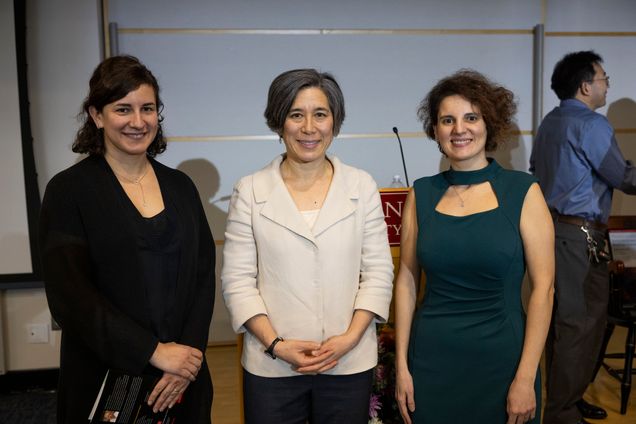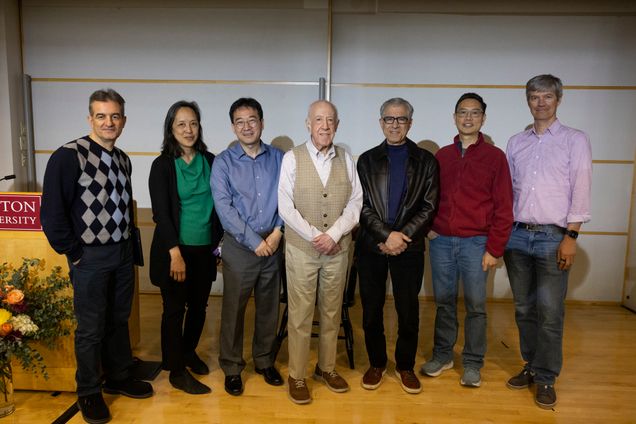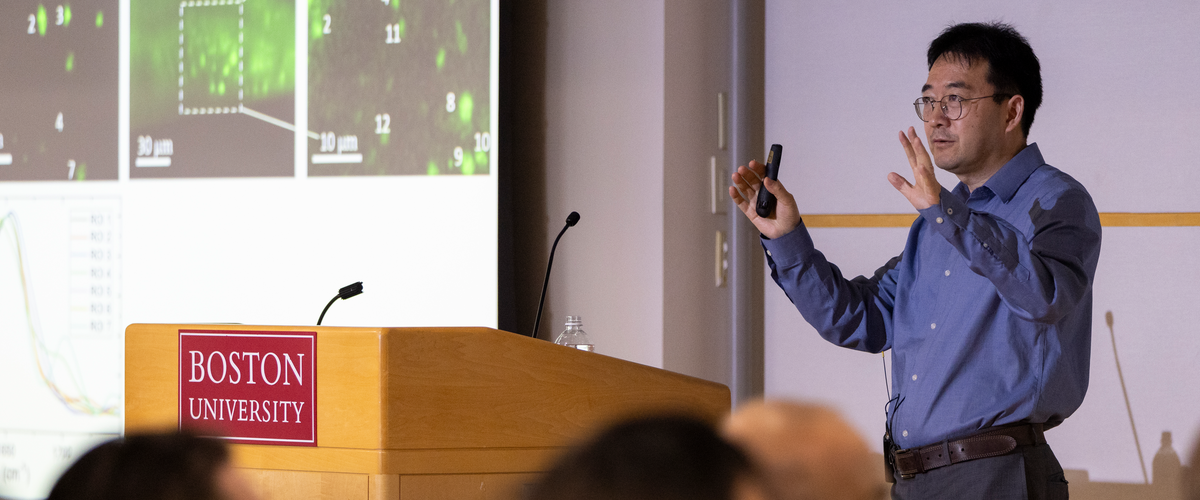Ji-Xin Cheng Delivers 2024 DeLisi Lecture
By Isabella Bachman
Moustakas Chair Professor of Photonics and Optoelectronics Ji-Xin Cheng (ECE, BME, MSE) was honored with the 2024 Charles DeLisi Award and Lecture on April 2. He presented his talk, “Seeing the Unseen Using Molecular Fingerprints,” to a packed Photonics Colloquium Room.
The DeLisi Award is conferred annually on a researcher who has advanced their field and society through outstanding, high-impact research, explained ENG Dean ad interim Elise Morgan. Morgan thanked the event’s namesake, Dean Emeritus Charles DeLisi, who was in attendance, for his generosity, service, and philanthropy to the college. Former ENG Dean and current BU Provost ad interim Kenneth Lutchen presented this year’s DeLisi Award to Cheng, whom he called “a science visionary,” with more than 30 patents and over 320 peer-reviewed articles with an h-index of 98.
Cheng, who also holds appointments in the CAS physics and chemistry departments in addition to his primary affiliation with ENG, related how his team’s trailblazing breakthroughs in chemical imaging over the past two decades have in part been the results of “serendipity” and persistence.
“Optical microscopy is a foundational tool for the life sciences,” Cheng said, but the technology faced gaps once thought insurmountable. After some years of failed experiments followed by “unexpected observations,” he said, Cheng helped bridge those gaps by co-inventing coherent anti-Stokes Raman scattering (CARS) microscopy as well as mid-infrared photothermal (MIP) microscopy to detect chemical bond vibration. These and other methods developed by Cheng have since been applied in labs and clinics around the globe.
At BU, Cheng, with Distinguished Professor M. Selim Ünlü (ECE, MSE, BME) and Associate Professor John Connor at BU’s Chobanian & Avedisian School of Medicine, applied the infrared technique to distinguish an RNA virus from a DNA virus based on chemical content. Published in Nature Communications, this method allows for virus subtyping and checking the quality of vaccines by imaging their chemical content.
Cheng’s vibrational photothermal microscopy techniques have many other important applications, such as imaging cell metabolic activity inside a living tumor spheroid, and 3D in vivo imaging of tissue content without slicing or tissue clearance.
In 2017, the MIP microscope Cheng reported in Science Advances was commercialized as mIRage by Anasys Instrument Inc., which has since brought 100 units to 15 countries for a variety of applications. From nanoscale imaging a Van Gogh painting in Belgium, to studying protein aggregation in Alzheimer’s disease in Sweden, to being used by Apple to examine the hard-to-reach crevices of semiconductor chips, Cheng’s invention has had a global, cross-industry impact.
Reflecting on his 20-year journey to breakthrough discovery, Cheng recited a short poem he wrote: “A small seed can grow into a big tree / It may take years and persistence is the key / How to find a seed? Slow down, and pay attention to unexpected scene.”
During a Q&A session following Cheng’s lecture, a student asked about the researcher’s thought process when designing novel technologies.
“You need a dedication when you pursue this career,” Cheng said. “I think about research when I drive, when I eat, maybe even when I fall asleep. The other thing you need is teamwork.”

Prior to Cheng’s lecture, Interim Associate Dean for Research and Faculty Development Ayse Coskun presented this year’s Early Career Research Excellence Award to Assistant Professor Rabia Yazicigil (ECE, BME), director of the Wireless Integrated Systems and Extreme Circuits Laboratory (WISE-Circuits Laboratory. The award recognizes outstanding achievements in establishing an impactful research program early in one’s career.
Reached after the event, Yazigicil expressed gratitude to the ECE department, ENG, and BU at large “for their support and for encouraging us, faculty, to chase these high-impact research problems requiring the convergence of disciplines. I am lucky to have many amazing collaborators here at Boston University to tackle societal challenges by crossing boundaries as a team. Lastly, a big thank-you goes to my students for working very hard to make these research outcomes possible and for being great team players.”
Charles DeLisi, who endowed the lecture series, served as dean of the college from 1990 to 2000. He recruited leading researchers in biomedical, manufacturing, aerospace and mechanical engineering, photonics and other engineering fields, establishing a research infrastructure that ultimately propelled the college into the top ranks of engineering graduate programs. In 1999, DeLisi founded—and then chaired for more than a decade—BU’s Bioinformatics Program, the first such program in the nation.

